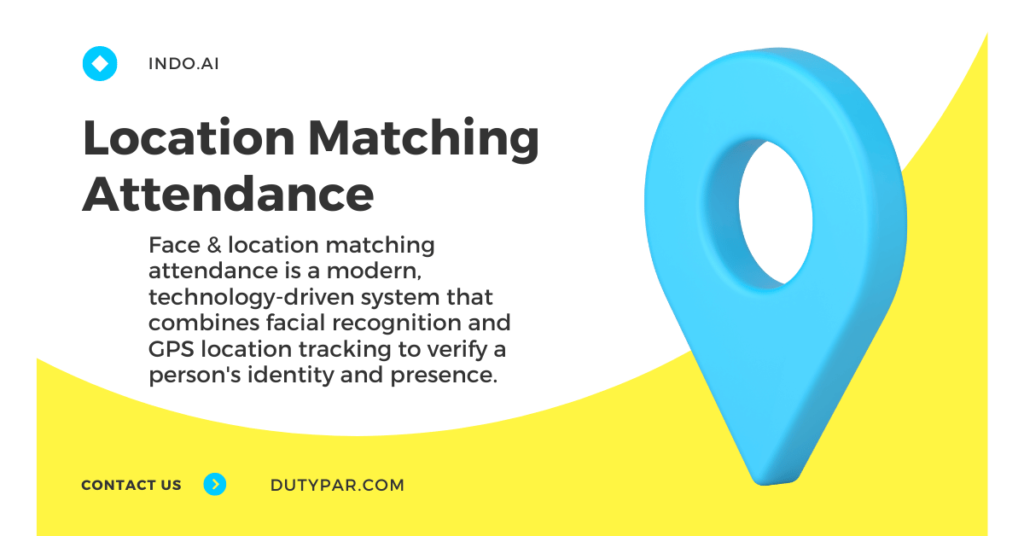
Table of contents
Introduction
In today’s busy world, it’s crucial for businesses, schools, and groups to know who is present. Old ways, like signing in or using cards, can be wrong, take a long time, and aren’t always right. But new technology has made things better. One new idea is a system that uses faces and where people are to check attendance. It looks at faces and tracks where people are to make sure workers or students are there when they should be and in the right place.
What is Face & Location Matching Attendance?
Face & location matching attendance is a modern, technology-driven system that combines facial recognition and GPS location tracking to verify a person’s identity and presence. This dual-verification ensures not only that an individual is present but also that they are physically located where they should be.
How Does It Work?
- Facial Recognition: A camera captures a person’s face. Advanced algorithms analyze facial features, including unique patterns and landmarks, to create a digital representation or template. This template is then stored in a secure database.
- Location Tracking: GPS technology determines the person’s location. This data is compared to pre-defined boundaries or zones, ensuring they are within the designated area.
- Data Verification: The system matches the captured facial data with the location coordinates in real time. If both match the pre-set criteria, attendance is marked.
- Attendance Log: The system records attendance information, including time stamps, location details, and any additional relevant data, for future reference.
Key Benefits
- Enhanced Accuracy: Reduces errors like proxy attendance or mistaken entries, ensuring accurate records.
- Improved Security: Harder for unauthorized individuals to manipulate the system or falsify attendance, safeguarding data integrity.
- Time Efficiency: Automates attendance tracking, saving time for administrators and users.
- Real-Time Data: Provides up-to-date attendance information for easy monitoring and decision-making.
- Remote Attendance: Supports remote verification for employees or students working from home, ensuring accountability and flexibility.
- Reduced Paperwork: Minimizes manual record-keeping, promoting efficiency and environmental friendliness.
Industries Benefiting
- Education: Ensures student attendance in classrooms and during off-campus activities.
- Corporate Sector: Tracks employee attendance, manages remote work, and ensures compliance with work hours.
- Healthcare: Monitors staff attendance in hospitals and care facilities, improving patient safety.
- Government & Public Sector: Manages employee attendance across various locations, enhancing accountability and efficiency.
Challenges
- Privacy Concerns: The use of facial recognition raises privacy concerns, as it involves collecting and storing personal data.
- Technical Glitches: Facial recognition and location tracking may experience errors due to factors like poor lighting, changes in appearance, or signal interference.
- Implementation Costs: The initial investment in hardware, software, and training can be a barrier for some organizations.
- Data Security: Protecting facial data and location coordinates requires robust security measures to prevent unauthorized access or data breaches.
Leading Companies
IndoAI site and DutyPar site are pioneers in face & location matching attendance technology, offering advanced solutions to businesses and institutions.
The Future of Face & Location Matching Attendance
Future advancements include:
- Improved facial recognition accuracy, even in challenging conditions like low lighting or changes in appearance.
- Enhanced location tracking precision, especially in indoor environments or areas with limited GPS signals.
- Integration with AI and IoT for more seamless operations, such as automatic adjustments to building access controls or meeting room bookings.
- Wider adoption in remote work environments, as companies continue to embrace flexible work arrangements.
Conclusion
Face & location matching attendance offers a more accurate, secure, and efficient way to track attendance. As technology continues to advance, we can expect even more innovative solutions in this area. By addressing challenges and leveraging emerging technologies, face & location matching attendance can become a valuable tool for businesses, educational institutions, and government agencies.
Face recognition technology has become an essential part of various sectors, including security, finance, healthcare, and education. One notable application is the face recognition attendance system, a solution widely adopted by organizations to streamline attendance management. But how does a face recognition attendance system work? This article will provide an easy-to-understand overview of how this technology operates and its key benefits. How Face Recognition Attendance System Works